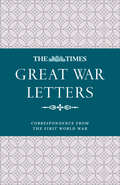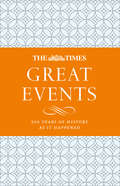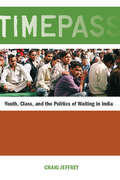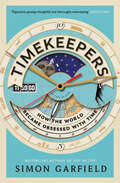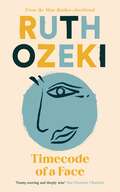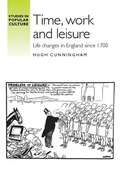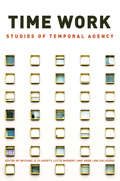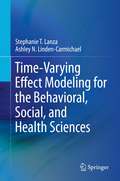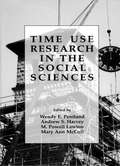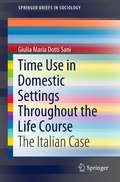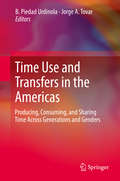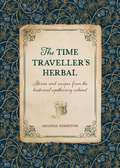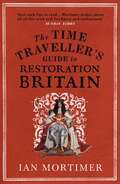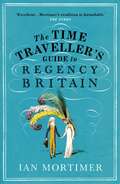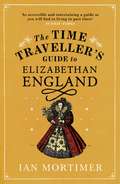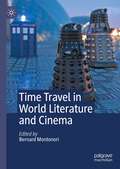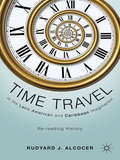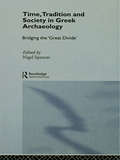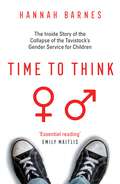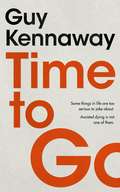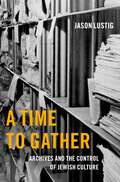- Table View
- List View
The Times Great War Letters: Correspondence During The First World War
by James Owen Samantha WyndhamSelection of more than 300 letters published by The Times newspaper between 1914 and 1918, as its readers and the nation alike endured the ordeal of the First World War.
The Times Great Events: 200 Years Of History As It Happened
by James OwenAs one of Britain’s leading newspapers for more than 200 years The Times has covered every major world events as they happened. This book profiles the ones that have had the most impact on the world today from the fall of the Berlin Wall to stepping onto the Moon.
Timepass: Youth, Class, and the Politics of Waiting in India
by Craig JeffreySocial and economic changes around the globe have propelled increasing numbers of people into situations of chronic waiting, where promised access to political freedoms, social goods, or economic resources is delayed, often indefinitely. But there have been few efforts to reflect on the significance of "waiting" in the contemporary world. Timepass fills this gap by offering a captivating ethnography of the student politics and youth activism that lower middle class young men in India have undertaken in response to pervasive underemployment. It highlights the importance of waiting as a social experience and basis for political mobilization, the micro-politics of class power in north India, and the socio-economic strategies of lower middle classes. The book also explores how this north Indian story relates to practices of waiting occurring in multiple other contexts, making the book of interest to scholars and students of globalization, youth studies, and class across the social sciences.
Timekeepers: How the World Became Obsessed With Time
by Simon GarfieldTime flies like an arrow, but fruit flies like a banana. The Beatles learn to be brilliant in an hour and a half. An Englishman arrives back from Calcutta but refuses to adjust his watch. Beethoven has his symphonic wishes ignored. A US Senator begins a speech that will last for 25 hours. The horrors of war are frozen at the click of a camera. A woman designs a ten-hour clock and reinvents the calendar. Roger Bannister lives out the same four minutes over a lifetime. And a prince attempts to stop time in its tracks. Timekeepers is a book about our obsession with time and our desire to measure it, control it, sell it, film it, perform it, immortalise it and make it meaningful. It has two simple intentions: to tell some illuminating stories, and to ask whether we have all gone completely nuts.
Timecode of a Face
by Ruth OzekiWhat did your face look like before your parents were born? Who are you? What is your true self? These are the questions in Ruth Ozeki’s mind as she challenges herself to spend three hours gazing into her own reflection, recording every thought and detail. What follows are a lifetime’s worth of meditations on race, ageing, family, death, the body, self-doubt and, finally, acceptance. In this profound encounter with memory and the mirror, Ozeki weaves together personal history, professional experience, Zen philosophy, Japanese culture and more to paint a rich, intimate and utterly unique portrait of a life as told through a face.
Time, work and leisure: Life changes in England since 1700 (PDF) (Studies in Popular Culture)
by Hugh CunninghamThis book traces the history of the relationship between work and leisure, from the ‘leisure preference’ of male workers in the eighteenth century, through the increase in working hours in the later eighteenth and early nineteenth centuries, to their progressive decline from 1830 to 1970. It examines how trade union action was critical in achieving the decline; how class structured the experience of leisure; how male identity was shaped by both work and leisure; how, in a society that placed high value on work, a ‘leisured class’ was nevertheless at the apex of political and social power – until it became thought of as ‘the idle rich’. Coinciding with the decline in working hours, two further tranches of time were marked out as properly without work: childhood and retirement. Accessible, wide-ranging and occasionally polemical, this book provides the first history of how we have imagined and used time.
Time, work and leisure: Life changes in England since 1700 (Studies in Popular Culture)
by Hugh CunninghamThis book traces the history of the relationship between work and leisure, from the ‘leisure preference’ of male workers in the eighteenth century, through the increase in working hours in the later eighteenth and early nineteenth centuries, to their progressive decline from 1830 to 1970. It examines how trade union action was critical in achieving the decline; how class structured the experience of leisure; how male identity was shaped by both work and leisure; how, in a society that placed high value on work, a ‘leisured class’ was nevertheless at the apex of political and social power – until it became thought of as ‘the idle rich’. Coinciding with the decline in working hours, two further tranches of time were marked out as properly without work: childhood and retirement. Accessible, wide-ranging and occasionally polemical, this book provides the first history of how we have imagined and used time.
Time Work: Studies of Temporal Agency
by Anne Line Dalsgård Michael G. Flaherty, Lotte MeinertExamining how people alter or customize various dimensions of their temporal experience, this volume discovers how we resist external sources of temporal constraint or structure. These ethnographic studies are international in scope and look at many different countries and continents. They come to the overall conclusion that people construct their own circumstances with the intention to modify their experience of time.
Time Work: Studies of Temporal Agency
by Michael G. Flaherty Lotte Meinert Anne Line DalsgårdExamining how people alter or customize various dimensions of their temporal experience, this volume discovers how we resist external sources of temporal constraint or structure. These ethnographic studies are international in scope and look at many different countries and continents. They come to the overall conclusion that people construct their own circumstances with the intention to modify their experience of time.
Time-Varying Effect Modeling for the Behavioral, Social, and Health Sciences
by Stephanie T. Lanza Ashley N. Linden-CarmichaelThis book is the first to introduce applied behavioral, social, and health sciences researchers to a new analytic method, the time-varying effect model (TVEM). It details how TVEM may be used to advance research on developmental and dynamic processes by examining how associations between variables change across time. The book describes how TVEM is a direct and intuitive extension of standard linear regression; whereas standard linear regression coefficients are static estimates that do not change with time, TVEM coefficients are allowed to change as continuous functions of real time, including developmental age, historical time, time of day, days since an event, and so forth.The book introduces readers to new research questions that can be addressed by applying TVEM in their research. Readers gain the practical skills necessary for specifying a wide variety of time-varying effect models, including those with continuous, binary, and count outcomes. The book presents technical details of TVEM estimation and three novel empirical studies focused on developmental questions using TVEM to estimate age-varying effects, historical shifts in behavior and attitudes, and real-time changes across days relative to an event. The volume provides a walkthrough of the process for conducting each of these studies, presenting decisions that were made, and offering sufficient detail so that readers may embark on similar studies in their own research. The book concludes with comments about additional uses of TVEM in applied research as well as software considerations and future directions. Throughout the book, proper interpretation of the output provided by TVEM is emphasized.Time-Varying Effect Modeling for the Behavioral, Social, and Health Sciences is an essential resource for researchers, clinicians/practitioners as well as graduate students in developmental psychology, public health, statistics and methodology for the social, behavioral, developmental, and public health sciences.
Time Use Research in the Social Sciences
by Wendy E. Pentland Andrew S. Harvey M. Powell Lawton Mary Ann McCollThis collection demonstrates the use and variety of applications of time use methodology from multidisciplinary, multinational, and multicultural perspectives. A distinguished roster of contributors from such fields as psychology, occupational therapy, sociology, economics, and architecture examines the complex relationship between human time utilization and health and well-being and evaluates the future of time use analysis as a research tool in the social sciences.
Time Use in Domestic Settings Throughout the Life Course: The Italian Case (SpringerBriefs in Sociology)
by Giulia Maria Dotti SaniThe volume is the first to take a life-course approach to the study of domestic work in Italy. It provides a coherent and systemic overview of time spent on housework, childcare and adult care over the life course. While most previous research has focused on the time adult women and men spend on housework and the division of domestic chores among partners, this unique contribution studies the amount of time spent on chores by Italians in different phases of the life course. It addresses relevant aspects often neglected in time use studies, such as the socialization to domestic chores among children, teenagers and young adults living in the parental home and the reproduction of gender inequalities in housework at later stages of the life course.
Time Use and Transfers in the Americas: Producing, Consuming, and Sharing Time Across Generations and Genders
by B. Piedad Urdinola Jorge A. TovarThis book provides a comparison of the measurement in time and monetary units of unpaid domestic work in Colombia, Costa Rica, Uruguay, and the Hispanic ethnicity in the United States. A standardized technique allows the development of comparable estimates across countries per age and gender which reveal specific behavioral patterns over the life cycle. A mixture of economic conditions, social norms, and demographic trends provide insightful explanations for the unequal burden that women and girls carry when dealing with unpaid domestic activities, an economically significant but traditionally neglected activity. As such, the book is of interested to practitioners in all social sciences, particularly sociologists, demographers, economists, and policymakers.
The Time Traveller's Herbal: Stories and recipes from the historical apothecary cabinet
by Amanda EdmistonThe herbalist has had many names throughout the ages - Cunning Woman, Wise Woman, even Witch - all hiding the truth of what they are... early pioneers of science, and fountains of traditional, nature-based knowledge.All around us are plants and herbs that can be used to improve our wellbeing and encourage a more nature-focused approach to health. Steeped in history, the herbalist's art paved the way for modern science - but didn't necessarily need to have been replaced by it. In The Time Traveller's Herbal, the traditional remedies and recipes that were passed down through the ages are offered to the modern reader as a means to reconnect with the natural world, while reaping the benefits. Steeped in the stories through which these remedies have been passed down to us, our connection to the past is fully explored in a romantic and meandering journey through the plants and flowers that have healed and helped us through the ages. Travelling back through the mists of time, the ancient mysteries of the plants and flowers that have saved lives in a world without modern medicine are uncovered. Told over the centuries, starting in ancient Rome, the reader journeys through time sampling the botanical marvels that did everything from soothing the pain of fever to revealing the world of the faeries, and learns the stories that surround us in the natural world. A guide to the myths of a lost art, The Time Traveller's Herbal is the book every budding apothecary should reach for.Including instructions for over 25 recipes and makes using commonly found, foraged or easily procured ingredients, author Amanda Edmiston weaves a story through the recipes about the craft of the herbalist, tapping into the traditional knowledge passed down through generations and reworking it for the modern reader.
The Time Traveller's Guide to Restoration Britain: Life in the Age of Samuel Pepys, Isaac Newton and The Great Fire of London (Ian Mortimer’s Time Traveller’s Guides)
by Ian MortimerThe past is a foreign country: this is your guidebook.If you could travel back in time, the period from 1660 to 1700 would make one of the most exciting destinations in history. It is the age of Samuel Pepys and the Great Fire of London; bawdy comedy and the libertine court of Charles II — the civil wars are over and a magnificent new era has begun.But what would it really be like to live in Restoration Britain? Where would you stay and what would you eat? How much should you pay for one of those elaborate wigs? Should you trust a physician who advises you to drink fresh cow’s urine to cure your gout? Why are boys made to smoke in school? And why are you unlikely to get a fair trial in court? The third volume in the series of Ian Mortimer’s bestselling Time Traveller’s Guides answers these crucial questions and encourages us to reflect on the customs and practices of daily life. This unique guide not only teaches us about the seventeenth century but makes us look with fresh eyes at the modern world.
The Time Traveller's Guide to Regency Britain (Ian Mortimer’s Time Traveller’s Guides)
by Ian Mortimer'EXCELLENT' - The TimesThis is the age of Jane Austen and the Romantic poets; the paintings of John Constable and the gardens of Humphry Repton; the sartorial elegance of Beau Brummell and the poetic licence of Lord Byron; Britain's military triumphs at Trafalgar and Waterloo; the threat of revolution and the Peterloo massacre. In the latest volume of his celebrated series of Time Traveller's Guides, Ian Mortimer turns to what is arguably the most-loved period in British history - the Regency, or Georgian England.A time of exuberance, thrills, frills and unchecked bad behaviour, it was perhaps the last age of true freedom before the arrival of the stifling world of Victorian morality. At the same time, it was a period of transition that reflected unprecedented social, economic and political change. And like all periods in history, it was an age of many contradictions - where Beethoven's thundering Fifth Symphony could premier in the same year that saw Jane Austen craft the delicate sensitivities of Persuasion. Once more, Ian Mortimer takes us on a thrilling journey to the past, revealing what people ate, drank and wore; where they shopped and how they amused themselves; what they believed in and what they were afraid of. Conveying the sights, sounds and smells of the Regency period, this is history at its most exciting, physical, visceral - the past not as something to be studied but as lived experience.
The Time Traveller's Guide to Elizabethan England
by Ian MortimerThe past is a foreign country - this is your guide, from the bestselling author of Time Traveller’s Guide to Medieval EnglandWe think of Queen Elizabeth I’s reign (1558-1603) as a golden age. But what was it actually like to live in Elizabethan England? If you could travel to the past and walk the streets of London in the 1590s, where would you stay? What would you eat? What would you wear? Would you really have a sense of it being a glorious age? And if so, how would that glory sit alongside the vagrants, diseases, violence, sexism and famine of the time?In this book Ian Mortimer reveals a country in which life expectancy is in the early thirties, people still starve to death and Catholics are persecuted for their faith. Yet it produces some of the finest writing in the English language, some of the most magnificent architecture, and sees Elizabeth's subjects settle in America and circumnavigate the globe. Welcome to a country that is, in all its contradictions, the very crucible of the modern world. ‘Vivid trip back to the 16th century…highly entertaining book’ Guardian
Time Travel in World Literature and Cinema
by Bernard MontoneriTime Travel in World Literature and Cinema discusses various literary works, movies, and TV series with a special focus on time travel. Each chapter is written by professors and scholars from various countries, including the US, Japan, Germany, France, Spain, Taiwan, South Africa, Qatar, Russia, Ukraine and Australia. The book addresses themes of racism, sexism, feminism, and social injustice as well as dystopian futures. This will appeal to students and scholars studying science fiction, dystopian literature, world literature, and world cinema.
Time Travel in the Latin American and Caribbean Imagination: Re-reading History
by R. AlcocerCombining in innovative ways the tools and approaches of postcolonial and popular culture studies as well as comparative literary analysis, this is an ambitious, interdisciplinary study that develops - across several related discursive sites - an argument about the centrality of time travel in the Latin American and Caribbean imagination.
Time, Tradition and Society in Greek Archaeology: Bridging the 'Great Divide' (Theoretical Archaeology Group Ser.)
by Nigel SpencerTime, Tradition and Society in Greek Archaeology is an innovative volume which examines the relevance of archaeological theory to classical archaeology. It offers a wideranging overview of classical archaeology, from the Bronze Age to the Classical period and from mainland Greece to Cyprus. Within this framework Spencer examines many of the issues which have become important in the study of archaeology in recent years - time, the `past', gender, ideology, social structure and group identity. The papers in this collection cover such diverse topics as the rural landscape, classical art and scientific methodologies. Over the last century the study of classical archaeology has been orthodox and static. The essays in this collection examine it in the light of current theoretical archaeology and anthropology, making it more relevant and valuable to the study of archaeology in the 1990s. This is a diverse and topical collection, of great value to classicists, ancient historians, anthropologists and everyone interested in new approaches to archaeology.
Time, Tradition and Society in Greek Archaeology: Bridging the 'Great Divide'
by Nigel SpencerTime, Tradition and Society in Greek Archaeology is an innovative volume which examines the relevance of archaeological theory to classical archaeology. It offers a wideranging overview of classical archaeology, from the Bronze Age to the Classical period and from mainland Greece to Cyprus. Within this framework Spencer examines many of the issues which have become important in the study of archaeology in recent years - time, the `past', gender, ideology, social structure and group identity. The papers in this collection cover such diverse topics as the rural landscape, classical art and scientific methodologies. Over the last century the study of classical archaeology has been orthodox and static. The essays in this collection examine it in the light of current theoretical archaeology and anthropology, making it more relevant and valuable to the study of archaeology in the 1990s. This is a diverse and topical collection, of great value to classicists, ancient historians, anthropologists and everyone interested in new approaches to archaeology.
Time to Think: The Inside Story of the Collapse of the Tavistock’s Gender Service for Children
by Hannah BarnesTime to Think goes behind the headlines to reveal the truth about the NHS’s flagship gender service for children. 'This is what journalism is for' Observer The Gender Identity Development Service (GIDS), based at the Tavistock and Portman Trust in North London, was set up initially to provide — for the most part — talking therapies to young people who were questioning their gender identity. But in the last decade GIDS has referred more than a thousand children, some as young as nine years old, for medication to block their puberty. In the same period, the number of young people seeking GIDS's help exploded, increasing twenty-five-fold. The profile of the patients changed too: from largely pre-pubescent boys to mostly adolescent girls, who were often contending with other difficulties. Why had the patients changed so dramatically? Were all these distressed young people best served by taking puberty blockers and then cross-sex hormones, which cause irreversible changes to the body? While some young people appeared to thrive after taking the blocker, many seemed to become worse. Was there enough clinical evidence to justify such profound medical interventions in the lives of young people who had so much else to contend with? This urgent, scrupulous and dramatic book explains how, in the words of some former staff, GIDS has been the site of a serious medical scandal, in which ideological concerns took priority over clinical practice. Award-winning journalist Hannah Barnes has had unprecedented access to thousands of pages of documents, including internal emails and unpublished reports, and well over a hundred hours of personal testimony from GIDS clinicians, former service users and senior Tavistock figures. The result is a disturbing and gripping parable for our times.
Time to Go
by Guy KennawayIn 2017 Susie Kennaway asked her son Guy to kill her.88 years old, with an older and infirm husband, Susie wanted to avoid sliding into infantilised catatonia. The son immediately started taking notes and Time to Go is the result.In turns a manual for those considering the benefits of assisted dying, a portrait of a mother son relationship, and a sympathetic description of old age, this book is a route map through the moral, legal, emotional, intellectual and practical maze that is the biggest issue facing the senior generations today: leaving life on their own terms.During their conversations about when and how to make Susie's final exit, some of the difficulties of their fractious relationship mellowed and some even melted, as the reality of what they were planning brought them together. Many elderly people, like Susie, have clearly stated that they wish to die in a manner and time of their choosing. But the church, the law, the medical profession and the pharmaceutical industry stand in the way, wagging their fingers. A change is coming for the rights of the elderly, the way it has come for the rights of women and gay people. Time to Go is a rallying call in this fight.Life is too precious not to be lived properly. As with a job, a relationship or a party, you have to know when it's time to go.
A Time to Gather: Archives and the Control of Jewish Culture (Oxford Series on History and Archives)
by Jason LustigHow do people link the past to the present, marking continuity in the face of the fundamental discontinuities of history? A Time to Gather argues that historical records took on potent value in modern Jewish life as both sources of history and anchors of memory because archives presented one way of transmitting Jewish history from one generation to another as well as making claims of access to an "authentic" Jewish culture. Indeed, both before the Holocaust and especially in its aftermath, Jewish leaders around the world felt a shared imperative to muster the forces and resources of Jewish life. It was a "time to gather," a feverish era of collecting-and conflict-in which archive-making was both a response to the ruptures of modernity, and a mechanism for communities to express their cultural hegemony. Jason Lustig explores how archives became battlegrounds over control of Jewish culture from the turn of the twentieth century to the cusp of the digital era. He excavates a tradition of monumental collecting, represented by repositories like the Gesamtarchiv der deutschen Juden, the German Jews' central archive formed in Berlin in 1903, alongside the Central Archives for the History of the Jewish People in Jerusalem and the American Jewish Archives in Cincinnati, both opened in 1947, which all showcase the continual struggle over "owning" the Jewish past. Lustig presents archive-making as an organizing principle of twentieth-century Jewish culture, as a metaphor of great power and broad symbolic meaning with the dispersion and gathering of documents falling in the context of the Jews' long diasporic history. In this light, creating archives was just as much about the future as it was about the past.
A Time to Gather: Archives and the Control of Jewish Culture (Oxford Series on History and Archives)
by Jason LustigHow do people link the past to the present, marking continuity in the face of the fundamental discontinuities of history? A Time to Gather argues that historical records took on potent value in modern Jewish life as both sources of history and anchors of memory because archives presented one way of transmitting Jewish history from one generation to another as well as making claims of access to an "authentic" Jewish culture. Indeed, both before the Holocaust and especially in its aftermath, Jewish leaders around the world felt a shared imperative to muster the forces and resources of Jewish life. It was a "time to gather," a feverish era of collecting-and conflict-in which archive-making was both a response to the ruptures of modernity, and a mechanism for communities to express their cultural hegemony. Jason Lustig explores how archives became battlegrounds over control of Jewish culture from the turn of the twentieth century to the cusp of the digital era. He excavates a tradition of monumental collecting, represented by repositories like the Gesamtarchiv der deutschen Juden, the German Jews' central archive formed in Berlin in 1903, alongside the Central Archives for the History of the Jewish People in Jerusalem and the American Jewish Archives in Cincinnati, both opened in 1947, which all showcase the continual struggle over "owning" the Jewish past. Lustig presents archive-making as an organizing principle of twentieth-century Jewish culture, as a metaphor of great power and broad symbolic meaning with the dispersion and gathering of documents falling in the context of the Jews' long diasporic history. In this light, creating archives was just as much about the future as it was about the past.
